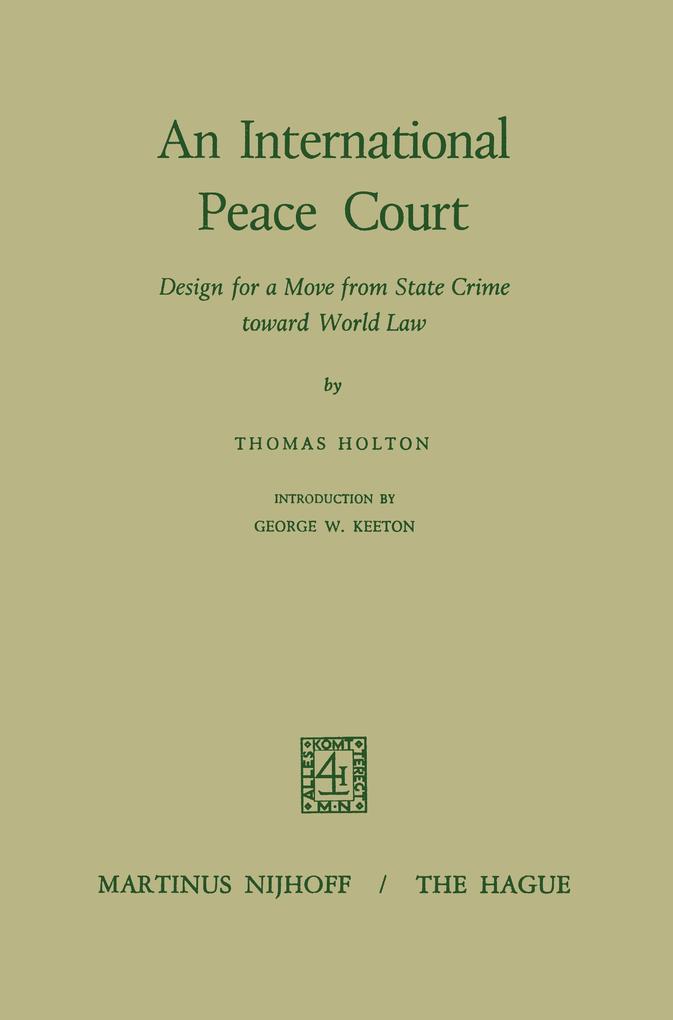Bücher versandkostenfrei*100 Tage RückgaberechtAbholung in der Wunschfiliale

Zustellung: Fr, 27.09. - Di, 01.10.
Versand in 6 Tagen
VersandkostenfreiBestellen & in Filiale abholen:
The classical concept ofInternationalLa w, as developed by Gentilis, Gro tius and their successors, accepted as its starting point the sovereignty of states, from which it followed that (r) the rules of International Law were based upon the general consent of those states; and (2) that, since state sovereignty was not capable of limitation, otherwise than by the consent of the state itself, in the last resort, International Law must accept the fact of war. Two world wars within the space of thirty years, and the development of nuclear weapons of unlimited potential, have compelled statesmen and lawyers to take a fresh look at the foundations of international relations. The First World War was followed by the creation of the League of Nations, and by the establish ment of the Permanent Court of International Justice. The failure of both, insofar as the preservation of peace was concerned, was apparent in the continuance of international insecurity, culminating in World War II. This again was followed by the establishment of a new inter national organisation, the United Nations, with its auxiliary, the International Court of Justice. Nevertheless, international security seems further away than ever, and it may be suggested that it is the devastating potential of nuclear weapons, rather than the strength of international machinery, which has so far prevented a third general conflict far more disastrous than either of the two World Wars which have already taken place.
Inhaltsverzeichnis
I. The Relevance of Law.- Responsibility for a Law of Peace.- The Placement of Responsibility.- The Format of Responsibility.- The Present Design.- II. International Violence: The Total Challenge and the Partial Response.- International Violence: The Total Challenge.- The Partial Response.- The Response Appraised.- III. Mission: A Move toward Law.- The Exercise of Responsibility.- Mission: A Move Toward World Law.- Credentials of Acceptability: Effectiveness and Legitimacy.- Summary.- IV. Medium: An International Peace Court.- The Choice of Means.- The Choice of Method.- The Choice of Medium.- V. The Court in Design.- Effective Structure.- Participants.- Summary.- VI. The Court in Action.- Jurisdiction.- Judges.- Parties.- Claims.- Trying the Facts.- Applying the Law.- The Judgment.- VII. The Court in Impact.- Operational Effect.- The Circuitry of Deterrence.- Legal Consequence.- VIII. New Premises for a Legal Breakthrough.- First Premise: The Initiative of the Many.- Second Premise: Moral Power as a Base of International Influence.- Third Premise: Moral Power Harnessed to Legal Structure.- Fourth Premise: Legal Judgment Free of the Consent of the Adjudged.- Fifth Premise: The Unique Method of Implementation of International Law.- Summary.- IX. Making the Move.- Establishment of the Court.- Maintenance of the Court.- Summary.- X. Toward World Law.- Blessed are the Peacemakers.- Making Peace.- Making Law.- Conclusion.- Epilogue.- Model Statute for an International Peace Court.- I. General Principles.- II. Organization of the Court.- III. Jurisdiction of Parties and Subject Matter.- IV. Procedure.- V. Amendment and Participation.- Author index.
Produktdetails
Erscheinungsdatum
01. Januar 1970
Sprache
englisch
Auflage
1970
Seitenanzahl
132
Autor/Autorin
Thomas Holton
Herausgegeben von
George W. Keeton
Verlag/Hersteller
Produktart
kartoniert
Abbildungen
XVI, 112 p. 1 illus.
Gewicht
213 g
Größe (L/B/H)
235/155/8 mm
Sonstiges
Paperback
ISBN
9789401181815
Entdecken Sie mehr
Bewertungen
0 Bewertungen
Es wurden noch keine Bewertungen abgegeben. Schreiben Sie die erste Bewertung zu "An International Peace Court" und helfen Sie damit anderen bei der Kaufentscheidung.









